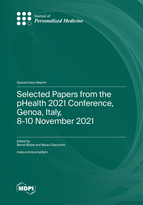Selected Papers from the pHealth 2021 Conference, Genoa, Italy, 8-10 November 2021
A special issue of Journal of Personalized Medicine (ISSN 2075-4426).
Deadline for manuscript submissions: closed (15 September 2022) | Viewed by 33716
Special Issue Editors
Interests: interoperability; data security; HL7; eHealth; medical informatics; electronic health records; health informatics; healthcare IT; oncology
Special Issues, Collections and Topics in MDPI journals
Interests: antibiotics; environment; infection; oncology; biodiversity; analysis; neural networks; classification; information technology; artificial neural networks
Special Issues, Collections and Topics in MDPI journals
Special Issue Information
Dear Colleagues,
This Special Issue of the Journal of Personalized Medicine presents extended versions of selected contributions to pHealth 2021, the 18th International Conference on Wearable Micro and Nano Technologies for Personalized Health, held on 8–10 November 2021 in Genoa, Italy. The original papers are published in the IOS Press Studies in Health Technology and Informatics 2021.
The 2021 edition of pHealth will emphasize the interrelated aspects of pHealth, i.e., personalized, participative, preventive, predictive precision medicine (5P medicine) in health and social services. In that context, mobile technologies, micro–nano–bio smart systems, bio-data management and analytics, artificial intelligence and robotics for personalized health, the Health Internet of Things (HIoT), systems medicine, public health, and virtual care are of interest, as are new potential risks for security and privacy, safety potential and challenges, trustworthiness of partners and processes, the motivation and empowerment of patients in care processes, and health system challenges in developing countries. The multilateral benefits of pHealth technologies for all stakeholder communities offer enormous potential, not only for medical quality improvement and industrial competitiveness, but also for managing health care costs and, last but not least, improving patient experiences. One important topic of the 2021 event will address digital health ecosystems in the context of 5P medicine.
Prof. Dr. Bernd Blobel
Prof. Dr. Mauro Giacomini
Guest Editors
Manuscript Submission Information
Invited manuscripts should be submitted online at www.mdpi.com by registering and logging in to this website. Once you are registered, click here to go to the submission form. Manuscripts can be submitted until the deadline. All papers will be peer-reviewed. Accepted papers will be published continuously in the journal (as soon as accepted) and will be listed together on the special issue Website. The invited manuscripts will cover research articles, review articles as well as short communications. For planned papers, a title and short abstract (about 100 words) can be sent to the Editorial Office for announcement on this website.
Submitted manuscripts should not have been published previously, nor be under consideration for publication elsewhere (except conference proceedings papers). All manuscripts are thoroughly refereed through a single-blind peer-review process. A guide for authors and other relevant information for submission of manuscripts is available on the Instructions for Authors page. Journal of Personalized Medicine is an international peer-reviewed open access monthly journal published by MDPI.
Please visit the Instructions for Authors page before submitting a manuscript. The Article Processing Charge (APC) for publication in this open access journal is 1800 CHF (Swiss Francs). Submitted papers should be well formatted and use good English. Authors may use MDPI's English editing service prior to publication or during author revisions.








